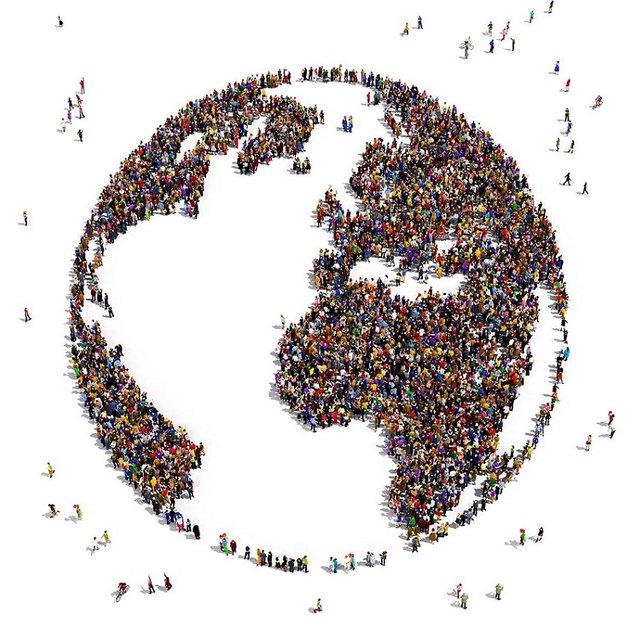Can We Solve the Problems of Overpopulation?

How many people live on the planet? I think the last number you've heard is 7 billion, maybe 7.2 billion. In the screenshot below you can see the relevant information…

It is the online counter of the population of the planet, on the website you can find a lot of other interesting information.
The problem of overpopulation of the planet is consistently in the top-lists of causes of death of human civilization. Environmental damage, caused by the industry, which is aimed at meeting our needs, is already apparent today.
In fact, the total fertility rate has been declining for the last 30 years, but life expectancy is increasing. According to the last UN report, we will reach the number of 10 billion by 2050. In 2100, our population will stabilize and will cease to grow at around 11-12 billion people.

According to many scientists, such rapid growth of population in a limited area with limited resources looks like a suicide. But, I think it looks not so hopeless, and future generations have a good chance for a happy life...
Space For Living
We have mastered 60% of all habitable land. The average population density on our planet today is 50 people per 1 sq.km. Of course, people are spread around the planet unevenly.
The population concentration is much higher near the equator and in urban areas. 4 billion people live in big cities. While huge areas of land are empty due to the harsh climatic conditions.

World population density: people/1 sq.km.
People live only on 8% of developed territory, all other lands are used as arable land, forage fields and forests. The problem is not the lack of space, but in its irrational use.
Do not forget that the land is only 30% of the surface of our planet. Nothing prevents us to expand habitat in the oceans. There are a huge number of projects of sea dwellings, from individual homes to entire cities. These structures can be much more effective than today's cities in economic and environmental terms.

Lilypad-Floating ecopolis
We used to live above the ground, but we also have the underground. In fact, this will allow to double the living area of all major cities, that exist today. Most likely, under the earth will live the poorest segments of the population. In a few centuries they will turn into the Morlocks from Wells novel…joking.
Food
All people of the world consume 400 million tons of meat and fish annually, and 2.1 billion tons of grain. 20 billion chickens, 1.5 billion and 1 billion sheep and pigs are sent to slaughter every year. At the same time, 842 million people in the world are starving.

30% of productive land given over to pasture for cattle and growing feed (only 4% is used for growing plant foods). This industry consumes almost 70% of all freshwater in the world
But, hunger is a problem only of poor countries. Developed countries utilize 30% of all produced food products every year. This food is suitable for consumption, it just lost marketability.
Every resident of the Golden billion throws it in the trash 1217 calories a day. It is about 60% of the average calorie intake for people leading a sedentary lifestyle.
Yes, we can feed 13 billion people, using modern methods of food production. But it will destroy the planet quickly. Today cows produce 18% of all methane, which accelerates the greenhouse effect.
Earlier I wrote about the production of meat out of the tube (In Vitro Meat). This is not synthetic meat, and the product on the basis of genetic material of animals, it is identical to natural meat. Every year the cost of production of such food is reduced.

The output of this technology at industrial level will solve not only the problems with providing the population with food. We will increase the area for human habitation 4 times, and we will be able to save 50% of all fresh water used today.
There is another way to feed the population, not so tasty… The country with the largest population has discovered it centuries ago. Insects - the source of colossal amounts of food with a high rate of self-reproduction.

For example: the biomass of all ants on the Earth is equal to 6 billion tons. Spiders annually consume 800 million tons of other insects- it is 2 times more than the volume of meat, that people eat each year.
Energy
The expansion of the space habitat and increase production of food require large amounts of energy. With an increase in the population by 27% in the period from 1990-2008, energy consumption increased by 40%. Today, 80% of all electricity is generated using minerals. Good news: alternative energy sources are conquering the planet.

Germany- the industrial locomotive of the Europe, today receives almost 50% of all energy from renewable sources (mainly from wind). Denmark already produces more energy than consumes and exports excess energy to neighboring countries. Costa Rica produces 99% of needed electricity from solar panels.

If we will cover 1% (86000 sq km) of the Sahara desert with solar panels, it will provide the whole world with electricity.
You can say that the sun does not shine 24 hours a day, 365 days a year, as the wind doesn't blow. It’s true. But, every day we're getting closer to conquering the energy of thermonuclear fusion. The safest source of almost infinite energy. Believe me, this is a topic for a separate article.

I'll give just one example to make you understand the advantage of this technology:
Burning one gram of wood will give us 7 thousand joules, coal- 34 thousand joules, oil or gas- 44 thousand joules. Burning one gram of isotopes using nuclear fusion will release 170 billion joules. The world consumes this amount of heat every 14 minutes.
***
As we can see, the main problems of overpopulation can be solved in the next decade. We have enough time until 2050, when the population, according to many scientists, will reach a critical threshold. Implement any of these technologies is much easier and realistic than to colonize other planets.
We started to produce irreversible negative changes on our planet 100 years ago, when the population was less than 2 billion. No matter how many people live on the planet: 7, 10 or 14 billion, with the right approach, the Earth can hold even 20 billion. The problem is not the number of people, but in how inefficiently and selfishly we provide our needs.

Our commitment to colonization is very commendable, I'm not saying we should abandon such projects. But first, we must to save our home, and not to leave it dying slowly because of our greed and haste. The solution to this problem will also significantly expand our space exploration capabilities.
sources: worldometers, House in the ocean, Population growth, 10 structures that could allow humans to live on the ocean, in vitro meat: the inevitable future, Wasted Food, Wasted Nutrients, How much food we will need in 30 years, NatGeo: spider's food, World_energy_consumption, Free energy in Germany, Wind- energy of future, Fusion_power, Naked-science, images from Google Search.

Thank you for spreading the truth of a very important disinformation campaign by the elites. @natord keep fighting the good fight!
Thank you for reading, my friend ! :)
I still think it is a problem, but I guess nature will always find a way. Nice article though :)
-world pandemic? :)
Thank you.
There's enough possibilities for us to provide ourselves in our needs. Enough space, enough food, the question is whether we able to distribute it well enough. Currently the rich countries waste their food while people in Africa are starving. Enough food but not at the right places.
You are absolutely right. The problem is that instead of cooperating, each playing for himself.
I loved this article. I have several problems with it, not trying to start a rant-avalanche, just wanted to inject another point of view if it helps. First of all we don't live on a planet. Its a planate. The over-population argument might be a myth. Many cities are very densely populated, some extremely. But I question the actual numbers offered by some estimates. I'm just saying let's look hard at where people live.
I wish I could find a trusted, fresh source of yummy insects to try. Anyone have some suggestions?
More than half of the population lives in large cities for obvious reasons: the infrastructure (electricity, water, medicine, work). Disproportionately well-developed infrastructure, within each country and around the world as a whole is the reason that we live in close quarters.
Unfortunately I don't know checked sources with tasty insects. I want to try too :)
This is an interesting article. I'll have to come back to this. I'm not eating ants though...let's get that straight right now...But...I'm also not into eating meating everyday either.
Honeypot ants are pretty tasty, the natives in Africa eat them instead of candy :)
Germany, Energy production 2016: 29% Renewables including 11.9% Wind. 53.6% Fossil, 13.1% Nuclear and 4.3% mixed other. This is fantastic progress in Germany but does not come close to "mostly wind power". As for the Saharan solar panels idea, what planet are you on? Articles such as this, full of bullshit, half-truths and outright lies, do not help the cause.
Source for German energy production:
https://www.cleanenergywire.org/factsheets/germanys-energy-consumption-and-power-mix-charts
Stand on Zanzibar!